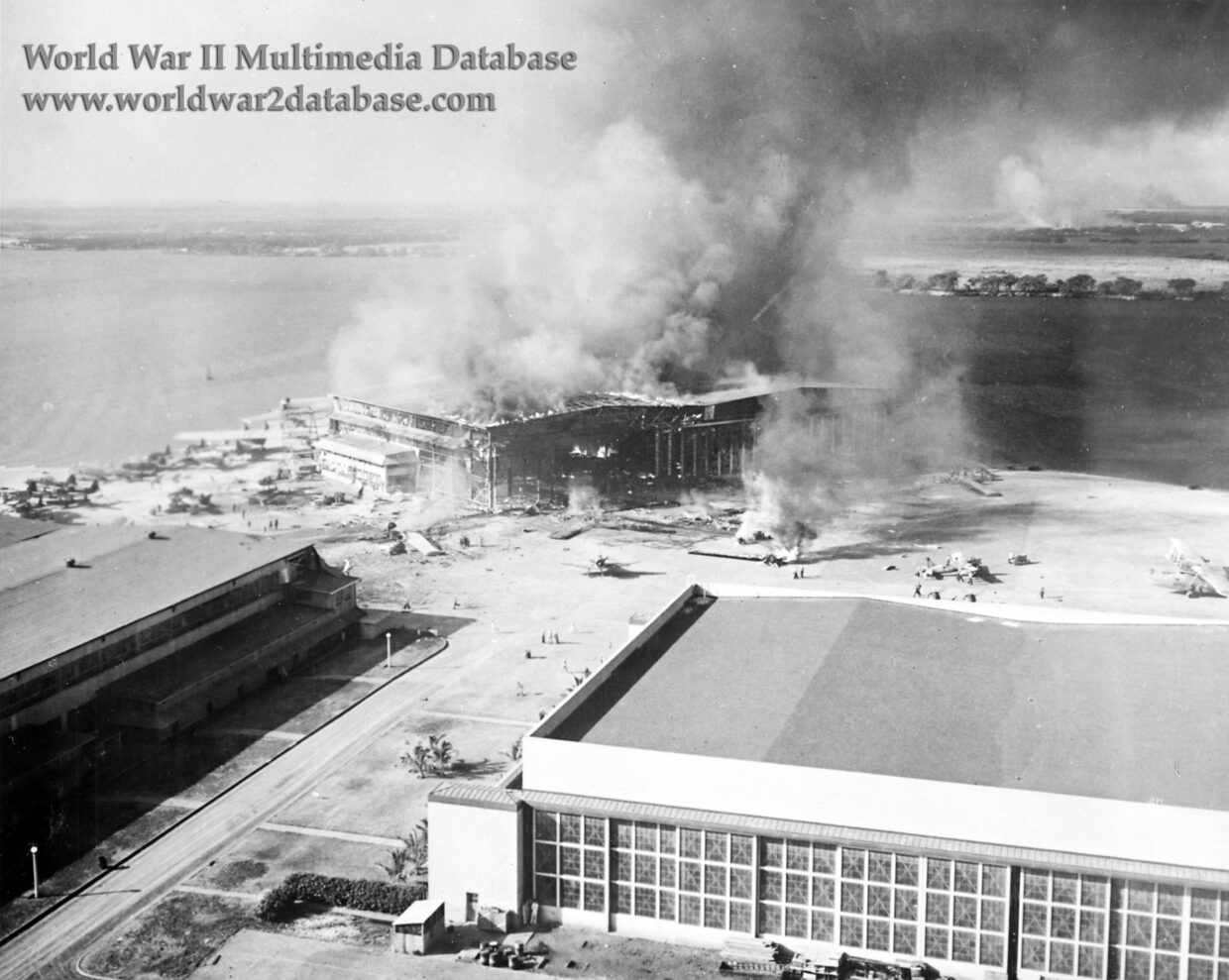| In a view taken from Ford Island‘s water tower, Hangar 6 at Ford Island Naval Air Station burns after bomb hits. Men can be seen pushing planes away from the conflagration and fighting the flames. In this view Consolidated PBY-5 Catalinas, Douglas SBD Dauntless carrier bombers and Chance-Vought OS2U Kingfisher floatplanes from the battleships and cruisers are visible; some are on fire. Hangar 6 was built in 1922 at a cost of $445,564 ($5,414,504 in 2009 dollars) and had rolling doors at both ends to allow planes to access either the water or the runway. During the 1920s and 1930s Hangar 6 was the site were planes shipped to Hawaii were assembled. By 1935 two squadrons of seaplanes were based there, and the battleship and cruiser spotter planes were repaired there as well. On December 7. 1941, Ford Island was home to Patrol Wing Two, consisting of squadron VP-21 (nine Consolidated PBY-5 Catalina patrol bombers), VP-22 (twelve PBY-3), PV-23 (twelve PBY-5) and VP-24 (six PBY-5, with only two present at Ford Island on December 7, 1941). There were 35 PBY patrol planes and 31 utility aircraft at the air station; three carrier air group SBDs were at Ford Island at the attack began, along with four Grumman F4F Wildcat fighters. Imperial Japanese Navy Aichi D3A Type 99 dive bombers led by Lieutenant Commander Kakuichi Takahashi of Shokaku, the first wave dive bomber group commander, scored hits on Hangar 6 in the opening moments of the attack. Imperial Japanese Navy Captain Mitsuo Fuchida (December 3, 1902 – May 3, 1976) broadcast “Tora! Tora! Tora!“ (Tiger! Tiger! Tiger!) and later recalled, “When Lieutenant Commander Takahashi and his dive-bombing group mistook my signal and thought we were making a non-surprise attack, his fifty-three planes lost no time in dashing forward. His command was divided into two groups: one led by himself which headed for Ford Island and Hickam Field, the other — head for Wheeler.“ Nine D3As first bombed the seaplane ramp, then turned Hangar 6 into an inferno. Observing the Japanese diver bombers, United States Navy Lieutenant Commander Logan C. Ramsey (February 26, 1898 – September 26, 1972) ordered Ford Island‘s radio room to send in plain English “Air Raid Pearl Harbor. This is NOT [a] drill“ which was passed through all American commands, reaching as far away as the United States mainland and Alaska. Ford Island was hit by eleven bombs during the attack (some of which were intended for USS California (BB-44) and struck Ford Island instead), and was repeatedly strafed. Hangar 6 was seriously damaged, with one third of its roof burning from five bomb hits. Aviation Ordnanceman First Class Theodore “Ted“ W. Croft, killed when three bullets hit his head, was the only casualty on Ford Island and may have been the first American to die in World War II. Most of the casualties in the base hospital were sailors from sunken vessels of Battleship Row and the west side of Ford Island; 130 men were treated for wounds. Twenty-six planes on the tarmac at Ford Island were destroyed out of seventy planes at Ford Island on December 7. As the battle continued, eighteen Douglas SBD Dauntless carrier bombers from USS Enterprise (CV-6) attempted to land, and six were shot down by Japanese fighters and Ford Island‘s now angered and aroused antiaircraft defenses. One SBD can be seen directly in front of Hangar 6, but that is probably not one of Enterprise‘s SBDs. When USS Arizona (BB-39) blew up at 0805 Hours, she settled on Ford Island‘s fresh water main, cutting off the fire hoses, hampering firefighting efforts; sailors were reduced to pushing planes out of the burning hangar and the fire was allowed to burn out. More worrisome for the Ford Island detachment was the presence of USS Neosho (AO-23), which was docked to refuel Ford Island‘s aviation gas tanks. Working under fire for forty-five minutes, sailors cut Neosho loose from gas lines connecting her to the island so she could move away in case she received a bomb and exploded. When USS Shaw exploded (DD-373) debris and shrapnel showered the men working on Ford Island to fight Hangar 6‘s fires. Hangar 6 was rebuilt using the original steel frame, which was mostly undamaged, and served as the busy center of seaplane operations throughout the war. It was demolished in 1985. One of the SBD-2s at Ford Island on December 7, Bureau Number 2106, had engine trouble, so it was left behind when USS Lexington (CV-2) sailed to reinforce Wake Island. In 1943, 2106 was lost on a training mission, and eventually recovered in 1993 restored, and returned to Ford Island‘s Pacific War Museum. | |
| Image Filename | wwii1380.jpg |
| Image Size | 1.71 MB |
| Image Dimensions | 2964 x 2363 |
| Photographer | Unknown |
| Photographer Title | |
| Caption Author | Jason McDonald |
| Date Photographed | December 07, 1941 |
| Location | Hangar 6 Ford Island |
| City | Pearl Harbor |
| State or Province | Hawaii |
| Country | United States of America |
| Archive | National Archives and Records Administration |
| Record Number | NRHS-21-DCHIHIHC-HC298-298REXH14(14) |
| Status | Caption ©2009, ©2024 MFA Productions LLC Please Do Not Duplicate or Distribute Without Permission |

Author of the World War II Multimedia Database

